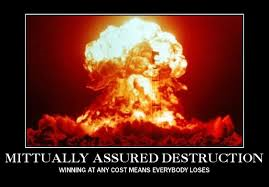Nuclear Weapons 138 - U.S. and Russia Are Still Locked In Cold War Mutually Assured Destruction
I have often blogged about nuclear war. This grim specter has been haunting the world since the 1950s. It was hoped that after the fall of the Soviet Union and the end of the Cold War that the risk of nuclear war would diminish. There has been a lot of work on disarmament and non-proliferation. Although a great deal of publicity has been given lately to the danger of Iran possessing a nuclear bomb, the two big players in the game are the U.S. and Russia, of course. The U.S. and Russia have reduced their nuclear arsenals by around eighty percent since the end of the Cold War, but that still leaves over four thousand warheads a piece.
Unfortunately, Russia under President Putin has been rattling nuclear sabers recently. He is talking about the possibility of moving nuclear weapons into Ukraine. He has been taunting NATO over Ukraine and NATO presence on Russia's western border, bragging that if a conventional war between NATO and Russia broke out in Eastern Europe and Russia appeared to be losing, he would consider the use of tactical nuclear weapons. This could, of course, rapidly escalate into a full scale nuclear war. Lately, Russian fighters and bombers have been flying near borders of other countries all over the world. The Russian planes do not have civilian type transponders to inform civilian planes and air traffic control and pose a danger to commercial flights.
The U.S. and Russia have been and are still operating under the "mutually assured destruction" doctrine of the Cold War. There are three basic options for launching nuclear weapons. The first is called "first strike" where a country just launches its missiles against another country without provocation. The second is to "launch on warning" if satellite radar systems detect missile launches from a hostile country. And the third is to "launch retaliatory missiles" following a nuclear attack.
The second scenario is the most dangerous. If warnings of hostile launches come, the decision makers in the U.S. only have about twenty minutes to decide whether there has actually been a launch of nuclear missiles. With the evolution of computer and satellite systems, the danger of a mistake in evaluating evidence of a nuclear launch had been diminishing. However, with the advent of cyber warfare, that possibility is rising again because a cyberattack could make it look like missiles had been launched and might prompt a country to launch its own missiles.
The last Russian satellite that could have detected missile launches from the American mainland or submarine failed last fall. Russia is deploying prefabricated radar stations along its borders to compensate for the loss of the satellites but that replacement system is far from complete. And even when it is complete, it can only give the Russia decision makers detailed information on incoming missiles when they are approaching Russia territory which gives Russian decision makers little more than ten minutes to verify that missiles are coming in.
Critics of the current situation have been calling for U.S. and Russian officials to eliminate the launch on warning option. There is a call to renew talks between high levels of the U.S. and Russian military which were suspended over the Ukrainian crisis. Any military exercises in either country that involve drills in launching missiles in response to missile launch warnings should be ended. The removal of the launch on warning option would fall under the New Start Treaty. After tensions diminish and full communications are restored between Russia and the U.S., a system of verifications could be developed. The reduction in the expansion and modernization of strategic nuclear forces in the U.S. and Russia should also be part of any agreement.
A full scale nuclear war between U.S. and Russia would mean the end of human civilization and the death of billions. Any steps that can be taken to reduce this risk of annihilation should be taken and as quickly as possible.
